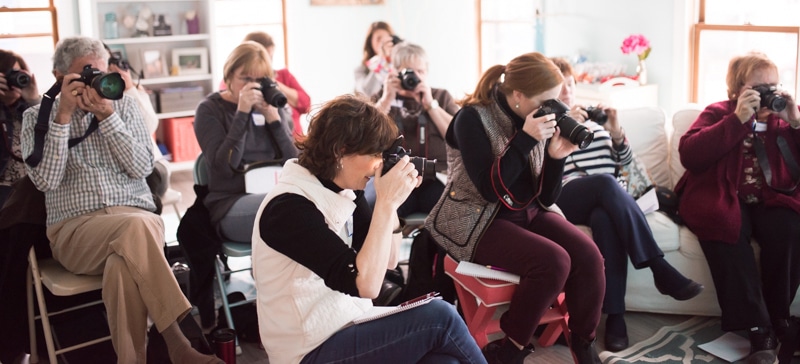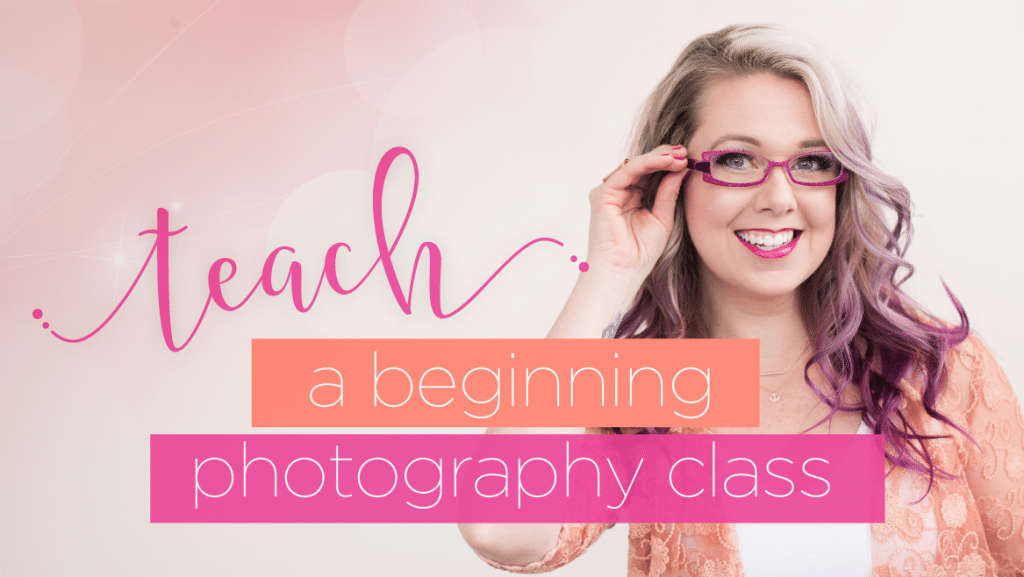Teaching a camera class for beginners is a smart way to add income… without raising prices or adding more photoshoots to your schedule!
You’re already working super hard on your photography business and the thought of adding one more thing can feel, well…. overwhelming. I get it, believe me I do. But if you’re not doing this one thing, you’re missing out on a substantial amount of income! Teaching a camera class is a great way to gain another stream of income {especially during the slow season} and I typically bring in $1,000-2,000 per day when I’m successfully marketing my classes.
Now do I have your attention?
But not only that, teaching a camera class adds a layer of professionalism and experience to your repertoire {#winning}! This will totally add street cred when you’re working with clients, businesses or community groups {as if they didn’t already know you were awesome!}. But, before you up the ante with your new class, I need to tell you a secret…
Don’t assume anything.
I know you love photography and that you’re eager to teach a camera class. You’re dreaming about the exposure triangle, buttery bokeh, and banishing yellow-tinged indoor photos once and for all…. but stop your sparkly little butt right there!
If you plan to start teaching beginning photography class and go immediately to the exposure triangle, you’re 100% on the wrong path!
Promise me you won’t make wild assumptions about what your students already know. I’m serious. Many ‘tog teachers assume too much about what enrollees know and then students begin the course in lost-mode. Guess what happens next? Because they are behind the curve, those fundamental skills aren’t in place to make the rest of your curriculum click. Don’t believe me? Here are some statistics from a nationwide survey that may blow your mind:
76% of people have no idea what depth of field is & why it matters in photography.
78% of people wouldn’t know what button or knob to use if they had to change their aperture.
83% of people were unable to select the correct definition of white balance when given 3 options.
{grab the rest of the survey results right here}
Mind blowing, isn’t it?! The things that are second nature to you and I are a foreign language to most of our students! So where do we start when there are so many important facets of photography?! Don’t worry, my little love bug! I’m going to take the hard out of it and treat you to four tips for teaching a camera class. These pointers will leave a lasting impression on your students and have them coming back for more!
4 hot ticket tips to remember when teaching a camera class!
1. Don’t go too far too fast!
If you’re thinking light meter exposure, white balance, and manual mode… dial it back, buttercup. Yes, you may have students who took photography in college or even heavy-hitting hobbyist photographers who claim to know the game. But don’t let these folks fool you! As it turns out, teaching {and reviewing} even the very basics with these cats will prove useful.
Case-in-point: Two of my photog friends sat in my beginner camera class recently. These ladies are great photographers, but confessed that they would have {unknowingly} skipped over the super-basics had they been in the teacher’s seat. They could see, by student reaction, how this information was truly new or a good review to include. They walked away with a woah-factor that confirmed what I already knew about the importance of teaching super basic skills.
You must get so very basic starting with, “how to hold your camera.” Include teaching material on how to change a lens, clean the camera, and manage files. These are all essentials that cannot be skipped.

At the end of the day, we want to give our clients the appropriate level of content. There is simply no way to cover everything there is to know about photography in 2-3 hours. It’s just not possible to do… or at least to do well. So, we want to avoid the overwhelm that comes with learning photography and do our best to focus on quality over quantity.
2. Start with the essentials {regardless of camera type}!
Think about essential things every photographer needs to know regardless of camera type. You will have aspiring ‘togs of all kinds sitting your class – so be prepared! Additionally, you’ll be teaching DSLR owners, smartphone photographers, those who love their point-and-shoot camera and those who shoot with mirrorless cams as well.
You’ll want to cover:
focus, proper use of light, and composition.
These three fundamental elements are to be taught… never assumed. If your students can master those three things, no matter what camera they are using, they will feel more confident at the end!
3. Explain why these things matter!
Take time to empower your students with the knowledge of how to take a better photograph. Most assume that a good camera takes a good photo, or that there’s some magical combination of settings that will always create a good photo, or that their kit lens will be able to create the same beautiful bokeh as your beloved 85mm. They honestly don’t know what they don’t know.
 It’s up to you to educate them.
It’s up to you to educate them.
Teach them to think. Teach them to troubleshoot. Then teach them to design a photograph with intention. That’s when the real learning happens! You’ll want to cover things like settings, ISO, aperture, and presets here. Because this is a lot to take in, you’re going to have to allow a little time for digestion. That brings us to #4…
4. Give students time to process what they’ve learned!
If your beginning photography class is anything like mine, you’ll cover a lot of new territories in a very short amount of time. But, if you present too much information, your students will get brain overload and retention levels will be down the tubes!
Your class is a lot like Pandora’s Box…
they may leave with more questions than they have answers!
If you just taught the rule of thirds, take a 10 or 15-minute break. Allow your students to apply the skill and then review the resulting photos. This will give you a good gauge of how the class is going. If it’s good, go on! If not, simply reteach until everyone has a basic level of understanding.
Teaching a camera class is not for the faint of heart, believe me, I know!
I’ve been teaching these classes for eight years and have had hundreds {if not thousands} of students walk through my doors. Before you teach your first class, there are eight essential steps you need to take including preparing your website, designing your curriculum, developing a marketing strategy and pricing yourself for profit. You can either figure all of that out of your own…… or save yourself a few million hours and download my simple checklist and let me tell you exactly what to do! I’ll see you in class!


+ show Comments
- Hide Comments
add a comment